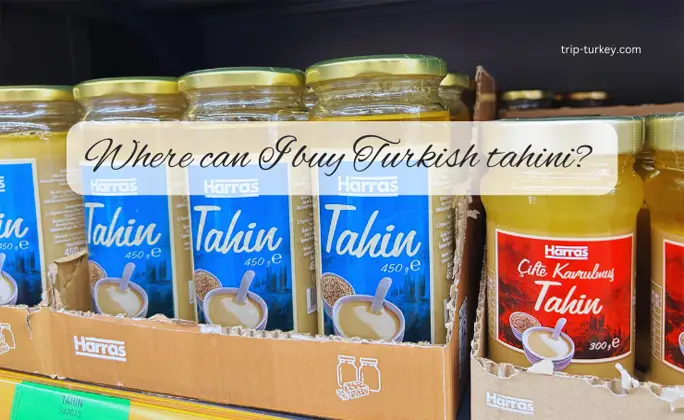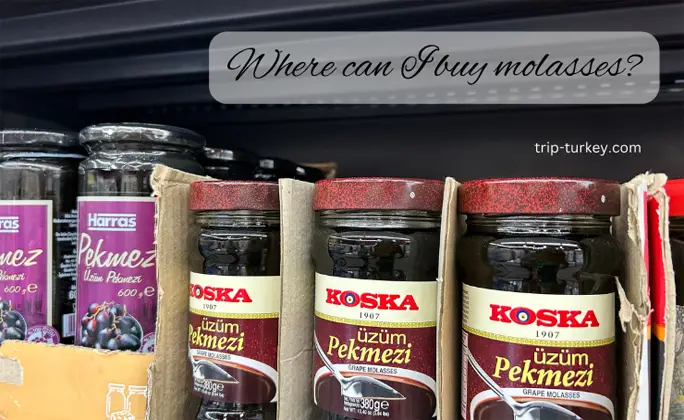Traditional mixture: Turkish tahini molasses

Turkish tahini molasses are the indispensable doublet of traditional breakfasts and Mediterranean diets. Especially in the East Mediterranean, Turkish tahini molasses became a part of culture besides the kitchen as well.
See best offers 👉🏻Turkish tahini molasses
This amazing duo has a very large industry in the food sector. Today, we mainly focus on what is Turkish tahini, what is Turkish molasses, variety of pekmez, Turkish tahini molasses, and their benefits.
In addition, we will talk about practical Turkish molasses & Turkish tahini recipes and where to buy Turkish tahini. Now let’s move on to our topic without wasting any time.
What is Turkish tahin?
Turkish tahini is a creamy, rich paste made primarily from crushed sesame seeds. A staple in Turkish cuisine, it’s an ingredient with deep historical roots and myriad uses in the kitchen.

Turkish tahini history
Tahini’s origins trace back to ancient civilizations, where sesame seeds were already being cultivated for their oil over 4,000 years ago. As trade routes expanded, the culinary use of sesame spread across the Middle East, North Africa, and eventually to Turkey. The Turkish variation, like in many Mediterranean regions, became an indispensable component in various dishes, both sweet and savory.
Turkish tahini ingredients
The primary and essential raw material for tahini is sesame seeds. In Turkey, the seeds are meticulously selected for quality. They are then roasted, which gives tahini its distinct nutty flavor and then ground to a silky-smooth paste. Some variations might add a bit of oil, salt, or other ingredients, but the core of Turkish tahini remains the sesame seed.

Turkish tahini recipes (usage areas)
There is not only one Turkish tahini recipe, because this product has a very large role in our cuisine. However, depending on your taste or the presentation you want to make, it is possible to apply any recipes you want in areas such as sweet, salty, sauce, and snacks.
Tahin Pekmez: This is a traditional Turkish snack or breakfast dish, combining tahini with grape molasses, creating a sweet and nutty spread perfect for bread.
Turkish tahini halva: This is perhaps one of the most iconic uses of tahini in Turkish cuisine. Halva, or “helva” in Turkish, is a sweet, dense confection made primarily from tahini and sugar or honey. Varieties might include additions like cocoa or nuts.
Spread or Dip: Just like one might spread peanut butter on toast, tahini can be spread on bread, especially in the morning with a drizzle of honey or molasses.
Baking: Tahini is used in some Turkish pastries and cookies, giving them a distinct flavor profile and moist texture.
Soups & Stews: It can be added to certain traditional soups and stews to lend depth and creaminess.
Mix with other ingredients: Tahini can be combined with ingredients like yogurt, garlic, and lemon to create a variety of flavorful dips or accompaniments to dishes. Also, there is a famous Turkish appetizer that is named “humus” and it’s also a good mixture of tahini and chickpeas.
Sauces & Dressings: Tahini is often whisked with lemon juice, garlic, water, and seasonings to create a sauce or dressing for salads, meats, or falafel. There is a traditional appetizer named “Turkish piyaz salad” and tahini is an indispensable ingredient of it.
How to eat tahin helva?
Turkish tahini halva can be eaten plain, with bread, for breakfast or as a dessert with tea. Turkish tahini benefits don’t end with counting. It is known to be an excellent source of fiber. It also increases the milk quantity and quality of breastfeeding mothers. It strengthens immunity.
Turkish tahini is more than just a paste—it’s a reflection of the country’s rich culinary heritage, versatile in its applications, and beloved by many. Whether in sweet treats like halva or savory dishes like sauces, its presence is undeniably integral to Turkish gastronomy.

Turkish tahini where to buy
You can buy Turkish tahini worldwide. If you are in Turkey, you can visit supermarkets or shopping centers. Also, you can order a bottle of liquid Turkish tahini or molded tahini halva in different varieties from Turkish online grocery shopping stores. Also, if you find tahini buns in bagel shops, bakeries, or patisserie shops, be sure to try them.
PURCHASE NOW 👉🏻organic tahini
As a Souvenir, you can take halva to your loved ones. If you are abroad, you can purchase it for yourself. See the offer for tahini halva pistachio which is my favorite one!
I did not forget the readers who are diabetics! You can eat diabetic tahini halva with peace in mind. It is definitely sugar-free.

What is Turkish molasses?
Turkish molasses, known as “pekmez” in Turkish, is a thick syrup made by reducing fruit or grain juices. It’s a natural sweetener, rich in minerals and vitamins, that has been a staple in Anatolian diets for centuries.

What is the history of pekmez?
Pekmez dates back to ancient times in Anatolia. Long before the advent of refined sugars, people in the region were boiling down fruit and grain juices to produce this nutritious syrup. Being a natural preservative, it offered a means to store and use the bounty of harvests throughout the leaner months. Its longevity as a staple in Turkish pantries speaks to its nutritional value and its adaptable role in various dishes.
What is Turkish molasses made of?
Pekmez can be made from a range of ingredients, each lending a distinct flavor and color to the molasses:
- Grape: Perhaps the most popular variety, grape molasses is made from the juice of boiled-down grapes.
- Mulberry: Made from mulberries, this type has a unique flavor and is highly valued.
- Carob: Carob molasses, or “harnup pekmezi” in Turkish, is made from the pods of the carob tree and is known for its rich, earthy taste.
- Fig and Apricot: Less common but equally delightful are pekmez versions made from figs and apricots.
- Grains: In some regions, especially where fruit might be scarcer, grains like wheat can be used to produce a type of pekmez.

What to do with pekmez? (Molasses usage areas)
Molasses usage areas are not wider than tahini. Because molasses have a sweet taste, that makes their usage areas shorter. Let’s take a look at them.
Breakfast: Pekmez is a traditional breakfast item, often drizzled on bread or mixed with tahini (tahin-pekmez) to form a sweet and nutty spread.
Desserts: It can be used as a sweetener in a variety of desserts, lending a richer flavor than regular sugar.
Baking: Pekmez can be used in place of sugars or syrups in certain baked goods.
Drinks: It can be diluted with water to create a refreshing beverage.
Natural Sweetener: In cooking, it’s a substitute for sugar or honey in various dishes.
Health and Medicinal Uses: Traditionally, pekmez has been consumed for its health benefits, including aiding digestion and boosting iron levels. It’s also given to children as a natural source of energy and nutrition.
What is pekmez good for?
Pekmez or molasses is a nutrient-rich sweetener that provides essential minerals, vitamins, and antioxidants beneficial for overall health. It is not just a sweet treat but a culinary heritage that has been nourishing generations with its natural goodness. Its versatility in the kitchen and its health benefits have cemented its place in Turkish cuisine and culture.
Turkish molasses where to buy
You can buy Turkish molasses around the world. If you are in Turkey, you can visit supermarkets and buy a lot of kind molasses. Also, you can order a bottle of liquid Turkish molasses in different varieties from Turkish online grocery shopping stores.
Turkish tahini molasses can be sold together as well. Even some street markets are selling molasses and tahini.
PURCHASE NOW 👉🏻 organic molasses syrup.

Turkish tahini molasses
Turkish tahini molasses is also known as “tahin pekmez” in Turkish language. If you are interested in Turkish words or free learning Turkish make sure you’ve checked my other blog posts.
Read & Learn 👉🏻 Frequently used Turkish words for tourists
This energizing and zestful duo is an amazing vitamin and mineral source. It provides energy. There are more benefits of Turkish tahini molasses which I will mention below. But before, let’s see the calories of this duo.

Tahini and molasses calories
The calorie content of tahini and molasses can vary based on the specific product and brand. However, here’s a general estimate:
Tahini’s approximately 89 calories per tablespoon (15g).
Molasses (specifically blackstrap) are approximately 58 calories per tablespoon (20g).
Do not forget! Once you’ve mixed them, you’ll get more calories. For precise caloric and nutritional information, it’s recommended to refer to the nutritional label on the specific product or consult a comprehensive food database.
Also, check out the article Does Tahin Go Bad?
Molasses and tahini benefits
When it comes to tahini molasses, people almost always ask the same question. Is molasses and tahini healthy? Yes, it is healthy, but only if you do not consume it excessively.
Turkish tahini molasses have many benefits and let’s get closer to these values now. Here are five benefits of Turkish tahini molasses!
- Rich Nutritional Profile: Combining the mineral-rich nature of tahini (which provides calcium, magnesium, and iron) with the vitamins and antioxidants found in molasses, Turkish tahini molasses is a powerhouse of essential nutrients.
- Natural Energy Boost: The combination of natural sugars from molasses and proteins and fats from tahini can provide a sustained energy release, making it a healthier alternative to refined sugar-laden snacks.
- Supports Bone Health: Tahini is an excellent source of calcium and phosphorus, both vital for maintaining bone density and health, while molasses provides additional minerals like magnesium which supports bone formation.
- Digestive Health: Molasses contains moderate amounts of fiber which, combined with the healthy fats in tahini, can aid digestion and promote a healthy gut.
- Heart Health: The unsaturated fats in tahini can contribute to maintaining healthy cholesterol levels, while the potassium in molasses can support proper heart function and blood pressure regulation.
Together, the blend of Turkish tahini and molasses offers a delightful taste with a myriad of health benefits.
SEE OFFER 👉🏻 Turkish tahini molasses price
Frequently Asked Questions About Turkish Tahini Molasses
Here are top asked questions about Turkish tahini molasses. If you have more questions about them, do not hesitate to contact me. There are countless brands, varieties, recipes, and more!
Is pekmez the same as molasses?
Yes, pekmez is the same as molasses. “Pekmez” is a Turkish word that is used in Turkey for molasses. Especially in Turkey, you can have the opportunity to try molasses made from different fruits and other food products. Such as mulberry, grape, carob, rosehip, fig, juniper. Additionally, it is possible to find completely different types of molasses locally.

